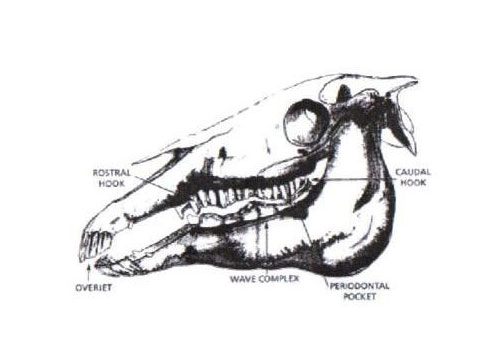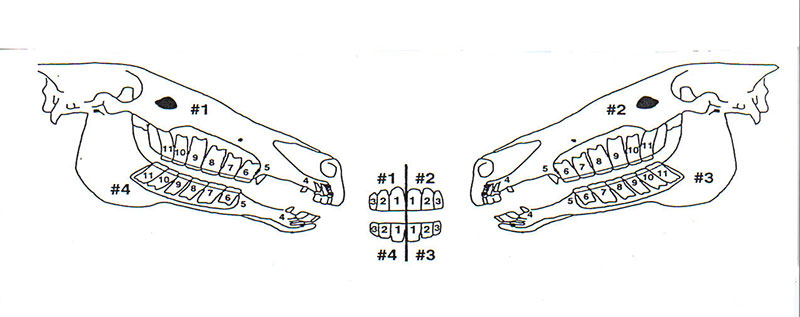A horses tooth growth is in response to a stimuli called an edonto blast. Every horse as well as every horses teeth respond differently to this growth stimuli which creates problems for our loved hard working friends. Since the molars or jaw teeth known as the molar tables grow at different rates even the regular tooth growth in a horses mouth causes problems in the desired chewing function. The desired angle for the molar tables is abt 10-15 degrees and the arcades level. The enhancement of the crush and grind function aids the horse in its ability to (MASTICATE)or crush its feed improving the food value of the feeds we purchase. Proper mastication of the feeds the horse injests greatly reduces the chance of colic ( Belly Ache ) in a horse. A horses jaw needs movement side to side (LATERAL) as well as forward and backward (ROSTAL & CAUDAL). A horses jaw needs freedom of movement when chewing as well as the jaw should be able to move forward when the head is lowered and back as the head is raised. Teeth that have grown at a faster rate than the others are known as protrubent teeth. A horses lower teeth are harder in their composition than the uppers. The stronger harder over powering lower teeth damage and destroy the weeker softer upper teeth creating what is called cupping. Many times the upper teeth are cupped out severly as much as being worn down to the gum line, many times the upper teeth are fractured and need extracting. The average growth of horses teeth is estimated at abt 1/8th of an inch per year. Normal growth and wear create VERY SHARP buccal (cheek) and lingual (tounge) enamel points that cut the cheeks and tongue creating cuts , lacerations, and ulcerated places and create alot of pain in chewing and mouth movements. Many times the mouth looks like someone has thrown a hand full of razor blades in there and said now chew with this. A horse chews at a rate of about 50,000 chews per day. As you see lots of pain and suffering are related with the lack of attention by owners when they neglect to properly maintain the horses mouth with at least yearly floating. Studies show that proper dental work in horses reduces the chance of colic about 80%. Money spent on dental work comes back in the health safety and well being of the horse as well as the ability of the owner to feed less feed to achieve the desired weight of their horse. It is said that money spent on dental work comes back in the savings on feed over the year. Not only does the horse recieve the health benifits from equine dentistry,but the pain factor is greatly improved. Relieving pain in the horses mouth greatly enhances attitude and useability of the horse. The pain relief and comfort in the mouth helps performance greatly by removing the thought of pain thus helping keep the horses mind on the job at hand. After dental work I have had numerious calls saying what did you do dental work or a brain transplant my horse works so much better and acts like a different horse. Please refer to the pictures and charts in this section to aid in a better understanding of the horses dental abnormalities.
Problems that may be found in a horses mouth in relationship with molar malocclusion.
- Caudal (back) lower hooks
- Rostal (front) upper hooks
- Front lower ramps
- Enamel points
- Sheared molar tables
- Peridontal disease
- ATR ( accentuated transverse ridges )
- Wave complexes
*Early correction and yearly maint. floating is the best way to care for the dental needs of the horse.

